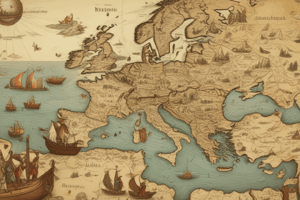Podcast
Questions and Answers
When did the Medieval Period begin?
When did the Medieval Period begin?
- 476 BC
- 8th Century AD
- 476 AD (correct)
- 1492 AD
What is the objective of understanding the social structure of medieval Europe?
What is the objective of understanding the social structure of medieval Europe?
- To know the agricultural practices of the time
- To learn about the inventions and discoveries of the medieval period
- To understand the roles of nobles, clergy, and peasants, and how they interacted (correct)
- To discover the geographical features of medieval Europe
What is the range of the Medieval Period in the subject?
What is the range of the Medieval Period in the subject?
- 8th to 14th century AD (correct)
- 10th to 16th century AD
- 5th to 15th century AD
- 7th to 13th century AD
What is the topic that discusses art, literature, and advancements during the medieval period?
What is the topic that discusses art, literature, and advancements during the medieval period?
Why is the medieval period considered a long period in history?
Why is the medieval period considered a long period in history?
What is the significance of 1492 AD in the medieval period?
What is the significance of 1492 AD in the medieval period?
What was the primary reason for the Silk Route being given its name?
What was the primary reason for the Silk Route being given its name?
What was the most common job in the Middle Ages?
What was the most common job in the Middle Ages?
What was the primary material used for manufacturing clothes in the medieval age?
What was the primary material used for manufacturing clothes in the medieval age?
What was the primary purpose of the state levying taxes on people during the medieval era?
What was the primary purpose of the state levying taxes on people during the medieval era?
What was the next most important industry after textiles in the medieval age?
What was the next most important industry after textiles in the medieval age?
What was the notable feature of the agriculture industry during the Middle Ages?
What was the notable feature of the agriculture industry during the Middle Ages?
What was the significance of Johannes Gutenberg's invention in the 15th Century?
What was the significance of Johannes Gutenberg's invention in the 15th Century?
What is the subject of the oil painting 'The Baptism of Clovis' by the Master of Saint Gilles?
What is the subject of the oil painting 'The Baptism of Clovis' by the Master of Saint Gilles?
What type of art is depicted in 'Goldsmith in this Shop' by Petrus Christus?
What type of art is depicted in 'Goldsmith in this Shop' by Petrus Christus?
What was the primary function of religious architecture during the Medieval Era?
What was the primary function of religious architecture during the Medieval Era?
What is a common feature of mosaics depicting Jesus Christ?
What is a common feature of mosaics depicting Jesus Christ?
What is the name of the bishop who baptized Clovis I, according to the painting 'The Baptism of Clovis' by the Master of Saint Gilles?
What is the name of the bishop who baptized Clovis I, according to the painting 'The Baptism of Clovis' by the Master of Saint Gilles?
Which of the following civilizations thrived in centers like Baghdad, Cairo, and Cordoba?
Which of the following civilizations thrived in centers like Baghdad, Cairo, and Cordoba?
What was the significance of the 14th century in the context of the Renaissance?
What was the significance of the 14th century in the context of the Renaissance?
What was the result of the Mongol Empire's expansion through military conquests?
What was the result of the Mongol Empire's expansion through military conquests?
What was a significant contribution of the Byzantine Empire?
What was a significant contribution of the Byzantine Empire?
What was a characteristic of Western Europe during the 10th-11th century?
What was a characteristic of Western Europe during the 10th-11th century?
What was the significance of the Crusades in the context of Western Europe?
What was the significance of the Crusades in the context of Western Europe?
What was the dominant social and economic system during the medieval period?
What was the dominant social and economic system during the medieval period?
What led to increased agricultural productivity during the medieval period?
What led to increased agricultural productivity during the medieval period?
What was the significant cultural and intellectual development that marked the end of the medieval period?
What was the significant cultural and intellectual development that marked the end of the medieval period?
What was the devastating pandemic that caused significant economic and social upheaval in Europe during the 14th century?
What was the devastating pandemic that caused significant economic and social upheaval in Europe during the 14th century?
What was the result of the Hundred Years' War between England and France?
What was the result of the Hundred Years' War between England and France?
What was a significant architectural achievement of the medieval period?
What was a significant architectural achievement of the medieval period?
Flashcards are hidden until you start studying
Study Notes
Medieval Period Overview
- The Medieval Period began around 500 AD and extended to approximately 1500 AD.
- Understanding the social structure of medieval Europe helps reveal the complexity of relationships and hierarchies that influenced historical developments.
- The period spans approximately a thousand years, indicating its lengthy impact on Europe and beyond.
Cultural Aspects
- Topics such as art, literature, and advancements during the Medieval Period fall under the study of Medieval Culture.
- The medieval period is considered long due to its significant duration and profound transformations in society, economy, and politics.
Key Historical Events
- The year 1492 AD is often cited as the end of the Medieval Period due to the discovery of the Americas, marking a significant shift in global dynamics.
- The Silk Route was named for its primary trade commodity, silk, essential to trade between Eastern and Western cultures.
Economy and Labor
- The most common job during the Middle Ages was agriculture, with the majority of people working as peasants or farmers.
- Wool was the primary material used for clothing, driving a significant textile industry during this era.
- States levied taxes primarily to fund military campaigns, infrastructure, and administration.
- After textiles, the next most important industry was agriculture, which dominated the economy.
Agriculture and Innovation
- Agriculture saw notable features such as the three-field system, improving crop yields and land usage during the Middle Ages.
- Johannes Gutenberg's invention of the printing press in the 15th century revolutionized information dissemination and literacy.
Art and Religion
- 'The Baptism of Clovis' by the Master of Saint Gilles depicts the baptism of the Frankish king Clovis I, signifying the spread of Christianity.
- 'Goldsmith in this Shop' by Petrus Christus exemplifies Northern Renaissance art, focusing on realism and everyday life.
- Religious architecture served primarily as places of worship, community gathering, and spiritual representation.
- Mosaics featuring Jesus Christ commonly display him in a frontal, authoritative pose, often surrounded by symbolic elements.
Notable Figures and Civilizations
- Bishop Remigius is credited with the baptism of Clovis I, showcasing early integration of monarchy and faith.
- Islamic civilizations thrived in centers like Baghdad, Cairo, and Cordoba, highlighting their advancements in science, philosophy, and culture.
Historical Context
- The 14th century marked the onset of the Renaissance, a significant cultural revival of classical learning and arts in Western Europe.
- The expansion of the Mongol Empire resulted in vast territorial control, enhancing trade routes and cultural exchanges.
- The Byzantine Empire's contributions included preserving Greek and Roman texts, influencing European thought during the Middle Ages.
Social and Economic Dynamics
- Western Europe during the 10th-11th centuries showcased feudalism as a dominant social and economic system, which structured society through land ownership and vassalage.
- The Crusades significantly impacted Western Europe, enhancing trade, cultural exchanges, and religious fervor.
Agricultural Innovations and Challenges
- Innovations like heavy plows and the introduction of new crops improved agricultural productivity during this era.
- The end of the Medieval Period is marked by significant cultural and intellectual developments, paving the way for the Renaissance.
- The Black Death was a devastating pandemic in the 14th century that led to economic decline and profound social changes in Europe.
War and Architecture
- The Hundred Years' War between England and France resulted in shifts in power dynamics and national identities.
- The medieval period is characterized by significant architectural achievements, such as Gothic cathedrals, which symbolized the era's artistic and engineering prowess.
Studying That Suits You
Use AI to generate personalized quizzes and flashcards to suit your learning preferences.





